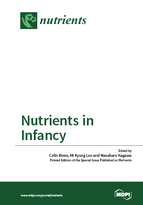Nutrients in Infancy
A special issue of Nutrients (ISSN 2072-6643).
Deadline for manuscript submissions: closed (30 September 2016) | Viewed by 252573
Special Issue Editors
Interests: public health nutrition; development of dietary guidelines; breastfeeding policy
Special Issues, Collections and Topics in MDPI journals
Interests: nutrition; public health
Special Issues, Collections and Topics in MDPI journals
Interests: public health; nutrition; anthropometry; body composition; body image; malnutrition
Special Issues, Collections and Topics in MDPI journals
Special Issue Information
Dear Colleagues,
Infants are not just small adults; they have a complex set of nutrient requirements and interactions to account for the high metabolic rate, growth, immunological and cognitive development, etc. Each year there are 138 million births, including 30 million from the least developed countries, where health is most at risk. Nutrition during infancy establishes growth patterns and development which moderate short term and long term health and life expectancy. There is continuing progress in understanding the nutrient composition of breastmilk and the importance nutritious and timely complementary foods. Nutrients at particular risk in the first years of life are iron, iodine, and vitamins A and D. There are still gaps in our knowledge on the influence of maternal diet, body composition and nutritional status on breastmilk nutrients. Interaction of nutrients with the human microbiome and gastro-intestinal tract hormonal secretion are developing fields. While breastmilk remains the “gold standard of pediatric nutrition”, the provisions of nutrients providing for optimal health in infant formulae, including nutrients and probiotics remains an area of research. The assessment of body composition for research and clinical practice has progressed rapidly and is important in understanding later obesity. After six months of age, there are new issues of the interaction of weaning foods and later family foods with the maturing gastro-intestinal tract to promote health and growth. Infant nutrition is made more difficult (and interesting) by the many cultural beliefs related to feeding practices. Developments in all of these fields of research into pediatric nutrition will be explored in this special issue together with state of the art reviews.
This Special Issue of Nutrients will focus on aspects of nutrition related to infancy, from birth until two years of age. We welcome the submission of manuscripts describing original research, meta-analyses or reviews of the scientific literature relating to infant nutrition. We look forward to your submissions and a thoughtful discussion of contemporary issues in nutrition of infancy across a spectrum of different cultures.
Prof. Colin Binns
Dr. Mi Kyung Lee
Assoc. Prof. Masaharu Kagawa
Guest Editors
Manuscript Submission Information
Manuscripts should be submitted online at www.mdpi.com by registering and logging in to this website. Once you are registered, click here to go to the submission form. Manuscripts can be submitted until the deadline. All submissions that pass pre-check are peer-reviewed. Accepted papers will be published continuously in the journal (as soon as accepted) and will be listed together on the special issue website. Research articles, review articles as well as short communications are invited. For planned papers, a title and short abstract (about 100 words) can be sent to the Editorial Office for announcement on this website.
Submitted manuscripts should not have been published previously, nor be under consideration for publication elsewhere (except conference proceedings papers). All manuscripts are thoroughly refereed through a single-blind peer-review process. A guide for authors and other relevant information for submission of manuscripts is available on the Instructions for Authors page. Nutrients is an international peer-reviewed open access semimonthly journal published by MDPI.
Please visit the Instructions for Authors page before submitting a manuscript. The Article Processing Charge (APC) for publication in this open access journal is 2900 CHF (Swiss Francs). Submitted papers should be well formatted and use good English. Authors may use MDPI's English editing service prior to publication or during author revisions.
Keywords
Infant nutrition
Growth and protein
Obesity in infancy
Micronutrients in infancy
Breastfeeding and nutrition
Nutrition education for infancy
Culture and nutrient intake









